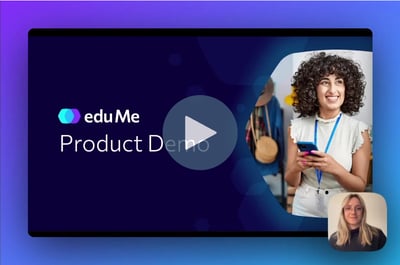According to our friends at Salesforce, continuous training can result in up to 50% higher net sales per representative. We know we’re preaching to the choir here…but if you need to convert less enlightened folk in your organisation, you’ll find lots of useful data points & evidence in our blog.
Now that’s been established, how do you ensure that your learning initiative is a resounding success and delivers clear ROI for your company? (And if you’d like to find out how to measure ROI, click here for our practical guide).
Check out our top 5 tips to supercharge your learning initiative:
1. Start by clearly communicating the value
First of all, your learners need to be motivated to use the learning tool, so give them a very good reason to participate. How will it benefit them personally? Will it help to increase their earnings, commission or tips, for example? Use a variety of communication channels to show how the training will enable learners to crush their sales targets, improve their negotiation skills, deal better with customer complaints…..This campaign could include launch events, emails, posters, and promotion on the company intranet, to name a few.
Check out our Motivation & Engagement Playbook for plenty more ideas on how to get your learners to start - and continue - using your learning platform.
2. Involve your learners from the outset
Test out the learning platform with a small group of users and managers to identify any sources of friction. You want to make the experience as smooth possible, so check for:
-
overall ease of use
-
quick sign up and sign in
-
easy access / availability on all devices.
Then, create a great first impression and keep up the momentum by releasing consistently good content on a regular basis. After launch, collect feedback from your learners to see what can be improved - allowing contribution of ideas will also result in them being more invested in the initiative.
3. Deliver a great mobile experience
Did you know that 70% of us use our mobiles for personal learning, but only 12% of corporate learning is mobile-enabled?
Time to catch up! Mobile learning is not simply shrinking existing desktop e-learning to fit a smartphone screen. We’ve seen plenty of examples of this and it’s really awful. Instead, think about what you and your learners do on your mobiles: you swipe, you tap, you click. Incorporate these functions to create a learning experience that’s as addictive as Facebook and as intuitive as WhatsApp.
For more inspiration, read our Insights Paper on How to Make Mobile Learning Work - we promise it does what it says on the tin!
4. Keep it concise, relevant, and challenging enough to maintain interest
In the words of L&D guru Josh Bersin, ‘today’s employees are overwhelmed, distracted, and impatient’. This means that your learners will take 5-10 seconds to decide whether to proceed with training, based on whether it looks relevant and will fit into their busy schedules. In our experience, the an online lesson should be focused on one topic and it should be under 5 minutes long. And yes, this is microlearning!
Get the level right - if your content is too difficult, learners may give up; too easy and they’ll get bored and won’t learn anything. Aim for the Zone of Proximal Development: learning happens in the sweet spot between the ‘comfort zone’ and the ‘panic zone’. Keep a close eye on quiz scores to make sure your content is pitched at the optimal level.
5. Use videos
We all love videos - in fact, 74% of all web traffic in 2017 was online video - so make sure your learning initiative incorporates them. Video is far more engaging than large blocks of text and it’s how we all prefer to consume content these days. The ‘keep it concise’ rule applies here too: attention spans won’t stretch to more than 2 minutes. Use real life situations that your learners can relate to and improve knowledge retention by using on screen text and graphics to highlight main takeaways. Finally, add subtitles to make it easy for learners who don’t want to enable audio on a crowded train when they forgot their headphones.
Videos don’t need to be Hollywood productions - you can create effective, engaging videos in-house using your existing software. Check out our blog series for lots of practical tips.






